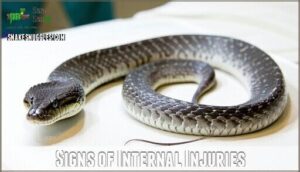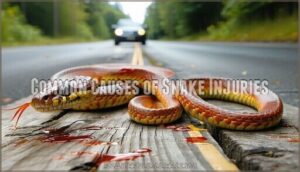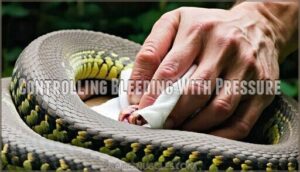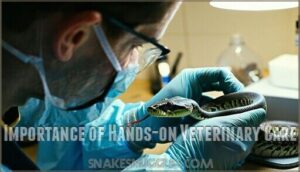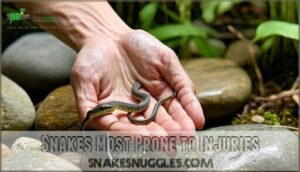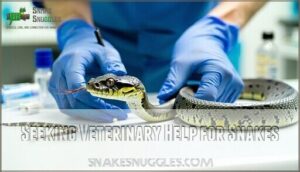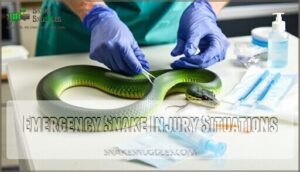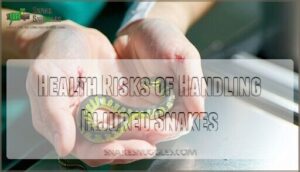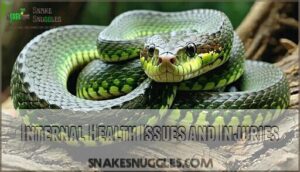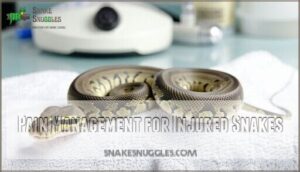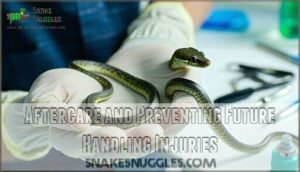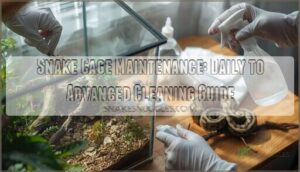This site is supported by our readers. We may earn a commission, at no cost to you, if you purchase through links.
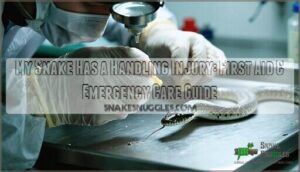
First, gently apply clean gauze or cloth to control any bleeding—don’t press too hard since snake skin is delicate.
Move your snake to a secure, warm enclosure away from stressors.
Keep temperatures within your species’ ideal range, as injured snakes struggle with thermoregulation.
Don’t attempt to clean wounds with water or antiseptics, as this can worsen tissue damage.
Monitor for signs like swelling, discoloration, or behavioral changes that indicate internal injuries.
Contact a reptile veterinarian immediately—snake injuries can deteriorate rapidly without proper treatment.
Understanding the specific signs and proper emergency protocols can mean the difference between recovery and serious complications, and it’s crucial to recognize the importance of immediate action for the snake’s well-being and to prevent serious complications.
Table Of Contents
- Key Takeaways
- Recognizing Snake Injuries
- First Aid for Injured Snakes
- Snakes Most Prone to Injuries
- Seeking Veterinary Help for Snakes
- Emergency Snake Injury Situations
- Health Risks of Handling Injured Snakes
- Internal Health Issues and Injuries
- Pain Management for Injured Snakes
- Aftercare and Preventing Future Handling Injuries
- Frequently Asked Questions (FAQs)
- Can snakes survive a snake injury?
- What happens if a snake is injured?
- How do you know if a snake is injured?
- Are snakes prone to injuries?
- Can a snake recover from a wound?
- What are common snake injuries?
- Can snakes recover from injuries?
- How can I help an injured snake?
- What do snakes do when in pain?
- How do you help an injured snake?
- Conclusion
Key Takeaways
- Act quickly and stay calm – Apply gentle pressure with clean gauze to control bleeding, then move your snake to a warm, secure environment away from stressors while you arrange veterinary care.
- Don’t attempt DIY treatments – Avoid cleaning wounds with water or antiseptics, as this can worsen tissue damage; instead, focus on basic bleeding control and temperature maintenance until professional help arrives.
- Watch for hidden internal injuries – Monitor your snake for behavioral changes, lethargy, difficulty moving, or unusual breathing patterns that signal serious internal damage requiring immediate veterinary attention.
- Find a reptile-experienced veterinarian immediately – Snake injuries deteriorate rapidly without proper treatment, so contact a reptile specialist rather than a general vet for accurate diagnosis and species-specific care.
Recognizing Snake Injuries
When you suspect your snake has been injured during handling, quick recognition of the problem is your first priority.
Look for visible wounds like cuts, swelling, or unusual coloration, while also watching for behavioral changes that might signal internal damage.
Identifying Visible Wounds
When evaluating your snake for a handling injury, you’ll need to conduct a thorough wound assessment to identify injury types and visible signs.
Look for these key indicators during your snake injury assessment:
- Color changes – redness, darkening, or discoloration around the wound area
- Swelling causes – puffiness, inflammation, or raised tissue indicating trauma
- Bleeding control needs – active bleeding, dried blood, or seepage from wounds
- Bite wound patterns – distinctive "V" shaped marks or puncture wounds
- Surface damage – scabbing, crusting, or broken skin requiring snake wound treatment
Quick identification of these visible wounds helps determine the severity of your snake handling injury and guides appropriate wound management decisions.
Signs of Internal Injuries
While visible wounds are obvious, internal injuries require careful observation.
Watch for behavioral changes, lethargy, appetite loss, or movement difficulty. Dark spots, bruising, or bleeding beneath the skin signal internal bleeding.
Hidden injuries demand immediate attention—watch for subtle signs that reveal serious internal damage.
Your snake may also display signs of distress like irregular breathing or unusual posturing. These internal injury signs demand immediate veterinary attention.
Common Causes of Snake Injuries
Dog bite injuries and glue trap dangers are leading causes of snake injuries.
Road accident trauma frequently occurs when snakes cross pathways.
Habitat hazard causes include incorrect temperatures, humidity levels, and sharp objects in enclosures.
Improper handling by inexperienced owners creates handling injury risks.
Snake injury prevention starts with understanding these common snake injury causes and implementing safe handling practices in your daily care routine.
First Aid for Injured Snakes
When your snake sustains a handling injury, immediate first aid can prevent complications and promote healing.
Quick action to control bleeding and create a safe environment sets the foundation for successful recovery.
Controlling Bleeding With Pressure
After you’ve identified the injury, immediate bleeding control becomes your priority. Applying pressure with a small cloth strip or gauze helps stabilize the wound until professional help arrives.
Key bleeding control steps:
- Use safe materials like clean gauze or soft cloth strips
- Apply gentle, steady pressure for pressure duration of 2-3 minutes
- Monitor for continued bleeding during post-pressure care assessment
Remember, your pet first aid kit should include reptile-safe supplies for effective wound management. Having the right first aid supplies is crucial for reptiles. This snake injury first aid technique provides essential bleeding control while you arrange veterinary transport.
Providing a Safe and Warm Environment
Create a separate enclosure immediately after controlling bleeding. This recovery space needs Temperature Gradients around 85°F with proper Humidity Levels maintained consistently.
Enclosure Security prevents escape while Stress Reduction occurs through dim lighting and Hiding Places. Easy cleaning materials are essential for maintaining a sanitary environment.
Monitor your snake closely in this controlled environment.
| Recovery Element | Specification | Purpose |
|---|---|---|
| Temperature | 85°F gradient | Promotes healing metabolism |
| Humidity | 50-60% levels | Prevents dehydration |
| Lighting | Dim/subdued | Reduces stress response |
| Substrate | Clean paper towels | Easy monitoring/cleaning |
| Hide box | Snug, secure fit | Provides comfort/security |
Importance of Hands-on Veterinary Care
Getting professional help isn’t optional—it’s essential. Expert Assessment from reptile specialist vets provides accurate diagnosis and Wound Management that DIY care can’t match.
Professional snake care isn’t a DIY project—your reptile’s life depends on expert diagnosis.
They’ll evaluate for Internal Injuries and determine if Surgical Intervention is needed.
- A vet examining your snake’s wounds under proper lighting and magnification
- Diagnostic imaging revealing hidden fractures or organ damage
- Follow-up Care appointments tracking your snake’s healing progress
Veterinary care from experienced reptile specialist vets guarantees proper snake injury treatment and snake wound care through expert veterinary care.
Snakes Most Prone to Injuries
When you’re handling snakes, certain species face higher injury risks due to their unique characteristics. Species predisposition plays a vital role in snake injuries, with some breeds being naturally more vulnerable than others.
Size matters substantially – smaller snakes like garter snakes suffer handling injuries more easily due to their delicate, slender build. Their fragile bones can’t withstand improper grip pressure.
Temperament impact affects injury likelihood too. Defensive species may injure themselves during escape attempts, while docile breeds face different risks.
Snake Species Injury Risks
Captivity effects and common ailments vary by species, making proper snake injury care essential for each breed’s specific needs.
Seeking Veterinary Help for Snakes
When your snake sustains a handling injury, finding qualified veterinary care quickly becomes your top priority.
Not all veterinarians have experience treating reptiles, so you’ll need to locate a specialist who understands snake anatomy and emergency care protocols, particularly one with knowledge of reptiles.
Finding a Local Reptile Veterinarian
When your snake needs urgent care, time matters.
The Association of Reptilian and Amphibian Veterinarians (ARAV) directory helps you locate reptile-savvy vets quickly.
Check specialist equipment availability, emergency hours, and reviews from other snake owners.
Don’t forget cost considerations – reptile specialists often charge more but provide better outcomes than general vets.
Identifying and Avoiding Potential Pitfalls in Care
Watch out for common missteps that can worsen your snake’s handling injury. Overhandling stressed snakes increases injury risk by 50%, while DIY treatments often backfire without proper expertise.
Key pitfalls to avoid:
- Habitat hazards – Sharp edges, improper substrates, and unsafe products create additional injury risks
- Handling mistakes – Rough restraint or inadequate support can cause musculoskeletal damage
- DIY treatments – Home remedies delay proper snake wound care and may introduce toxins
- Misinformation risks – Online advice without veterinary backing can harm recovery outcomes
- Ignoring snake habitat safety – Poor environmental conditions impair healing and immune response
Professional snake injuries require expert assessment. Safe handling skills and proper preparation prevent complications during transport to qualified reptile veterinarians.
Recommended Search Process for Expert Veterinary Help
Finding appropriate veterinary care for your pet snake injury requires a systematic approach.
When your snake suffers a handling injury, time matters for proper treatment outcomes.
Start by utilizing these key resources to locate qualified reptile-savvy vet professionals:
- Online directories like the Association of Reptile and Amphibian Veterinarians website provide verified specialist listings
- Enthusiast referrals from local reptile communities and snake owner groups offer trusted recommendations
- Review websites help evaluate veterinary care quality and patient experiences with snake treatments
- Emergency clinics should be contacted immediately to confirm reptile care availability during critical situations
- Vet expertise verification through direct consultation about snake handling injury experience confirms proper treatment.
Look for vets familiar with snake-specific medical needs to guarantee accurate diagnosis.
Emergency Snake Injury Situations
When your snake sustains a handling injury, immediate stabilization becomes your priority until professional veterinary care is available.
Quick assessment and proper first aid can substantially impact your snake’s recovery outcome and prevent complications from developing, which is crucial for a successful recovery with minimal complications.
Care and Stabilization Until Medical Attention Arrives
Once you’ve located a reptile veterinarian, your immediate priority shifts to stabilizing your injured snake. Time becomes your ally when you act quickly and methodically.
| Stabilization Action | Purpose | Method |
|---|---|---|
| Control bleeding | Prevent shock | Apply gentle pressure with sterile gauze |
| Maintain warm environment | Support metabolism | Keep temperature at 75-85°F |
| Monitor wound | Track condition | Check for swelling or discharge |
Create a secure, escape-proof container with adequate ventilation for transport. Always have essential wound care readily available in your reptile first aid kit.
Apply reptile antiseptic to visible wounds after cleaning gently with saline solution. Conduct a pain assessment by observing your snake’s movement and responsiveness.
Remember, handling injury complications can worsen without proper stabilization, so minimize unnecessary movement until professional help arrives.
Triaging Acute Care Before or Enroute to Treatment
Time is critical when you’re racing to the vet with your injured snake. Every moment counts for proper stabilization and snake first aid during transport.
Assess Snake condition by gently examining visible wounds and monitoring behavior for signs of distress. Clean any wounds with a damp cloth – avoid harsh chemicals that could worsen the injury. Control Bleeding by applying light pressure with clean gauze if necessary.
Secure Transport in an escapeproof container with proper ventilation. Maintain a Warm Environment around 85°F to prevent shock and support healing. Antiseptic Application should wait until professional evaluation unless bleeding requires immediate attention.
Key priorities during snake transport:
- Monitor breathing and movement patterns
- Keep the container stable and temperature-controlled
- Document injury details for the veterinarian.
Your preparation and calm handling during this critical window substantially impacts treatment success and snake injury recovery outcomes.
Health Risks of Handling Injured Snakes
When you handle an injured snake, you’re not just dealing with the animal’s wounds—you’re also exposing yourself to potential health risks.
The most significant concern is salmonella transmission, which can occur through direct contact with the snake’s skin, scales, or any contaminated surfaces in its environment, posing a risk to your health.
Salmonella Risk
Handling injured snakes increases your Salmonella transmission risk substantially. Up to 90% of captive snakes carry these bacteria naturally, creating potential public health concerns during emergency care situations.
| Risk Factor | Transmission Route | Prevention Measures |
|---|---|---|
| Direct Contact | Snake saliva, feces, wounds | Wear gloves, avoid face touching |
| Cross-contamination | Contaminated surfaces, tools | Disinfect equipment immediately |
| Vulnerable Populations | Children under 5, immunocompromised | Limit exposure, seek medical advice |
| Environmental Spread | Terrariums, substrates | Clean enclosures regularly |
Bacterial transmission occurs through direct contact with contaminated surfaces or bodily secretions. Reptile hygiene tips emphasize proper safe handling techniques and immediate handwashing after contact to minimize Salmonella risk.
How to Minimize Disease Transmission
Your snake’s injury creates a perfect storm for disease transmission, making hygiene protocols essential. Proper wound cleaning with antiseptic and following reptile hygiene tips protect both you and your pet from zoonotic diseases.
Handling injuries can be avoided with proper handling techniques.
Essential hygiene practices to prevent transmission:
- Wear disposable gloves – Your first line of defense against dangerous pathogens
- Wash hands thoroughly – Scrub for 20 seconds after any snake contact
- Disinfect surfaces immediately – Clean all equipment and work areas with reptile-safe solutions
- Implement quarantine procedures – Isolate injured snakes from healthy animals
- Practice vector control – Eliminate contaminated bedding and food sources promptly
These snake handling injury precautions aren’t just suggestions—they’re your shield against serious illness.
Internal Health Issues and Injuries
While external wounds are obvious, internal injuries often hide beneath your snake’s scales and require careful observation to detect.
You’ll need to watch for subtle behavioral changes, swelling, or difficulty moving that signal deeper health problems requiring immediate veterinary attention, which can be critical for the snake’s survival due to potential internal injuries.
Snake Parasites and Infections
Beyond direct handling injuries, parasites and infections pose serious threats to your snake’s health.
External parasites like Ophionyssus natricis (snake mites) appear as tiny moving dots on skin and cause anemia. Internal parasites include nematodes and protozoans like Cryptosporidium, causing weight loss and abnormal feces.
Bacterial infections such as stomatitis (mouth rot) and fungal infections like scale rot thrive in poor conditions. Ophidiomycosis affects wild snakes particularly.
Regular fecal exams help detect these snake diseases early before they become life-threatening. Understanding zoonotic risks is vital for snake owners.
Tumors and Internal Swellings
Discovering unusual lumps on your snake can trigger immediate concern about potential health complications.
These abnormal swellings may indicate various snake health concerns ranging from benign cysts to serious malignancies requiring prompt veterinary intervention.
Tumor Types in snakes include lipomas, fibromas, and adenomas, while Swelling Causes encompass retained eggs, organ enlargement, or infectious processes.
Diagnostic Imaging through X-rays or ultrasounds helps veterinarians identify internal injuries and determine appropriate Treatment Options.
Common manifestations include:
- Visible lumps or asymmetrical body contours
- Changes in appetite or movement patterns
- Difficulty with normal bodily functions
- Unusual behavioral patterns during handling
- Progressive growth of suspicious areas
Preventative Measures focus on maintaining prime husbandry conditions and regular health monitoring.
Snake injury signs often overlap with tumor symptoms, making professional evaluation vital for accurate diagnosis and effective treatment planning.
Difficulty Shedding Skin
Shedding problems often indicate underlying reptile care issues that require immediate attention.
Stuck Shed Causes include inadequate Humidity Importance levels and poor environmental conditions.
Preventing Dysecdysis starts with proper husbandry practices and environmental monitoring.
| Shedding Issue | Primary Cause | Solution |
|---|---|---|
| Retained shed | Low humidity |
Pain Management for Injured Snakes
You can’t always see when your snake is hurting, but changes in behavior like reduced movement or appetite loss often signal pain.
Getting professional veterinary care is essential because reptile-safe pain medications and proper dosing require expert knowledge that goes beyond basic first aid.
Recognizing Pain in Snakes
Most snakes mask pain as a survival instinct, making pain assessment tricky.
Watch for behavioral changes like decreased activity, appetite loss, or unusual hiding patterns.
Physiological signs include labored breathing, abnormal posturing, or defensive responses.
Unlike mammals, snakes don’t vocalize discomfort, so you’ll need to observe subtle cues.
Chronic pain may cause persistent lethargy or altered movement patterns.
Document these observations to help veterinarians develop effective pain management strategies and determine analgesia efficacy for your snake’s recovery.
The Role of Veterinary Care in Pain Management
In the context of pain management for injured snakes, veterinary expertise makes all the difference.
A reptile-experienced vet will conduct thorough pain assessment using specialized techniques and develop targeted treatment protocols.
They’ll evaluate analgesic options while considering dosage considerations specific to your snake’s species and size.
- Chronic pain requires ongoing veterinary monitoring and medication adjustments
- Ethical implications of untreated pain demand professional intervention and proper care protocols
- Snake pain management involves species-specific approaches that only trained veterinarians can provide safely
Aftercare and Preventing Future Handling Injuries
Once you’ve addressed your snake’s immediate handling injury, focus on preventing future incidents through proper technique and preparation.
Establishing safe handling practices and creating an emergency response plan will protect both you and your snake from unnecessary stress and injury.
Educating Yourself on Safe Handling Techniques
Learning safe handling techniques prevents future injuries.
Read species-specific care manuals and take formal reptile handling courses to improve proficiency.
Practice proper support using both hands for larger snakes and make gentle movements to reduce stress.
Recognize distress signals like hissing or coiling.
Avoid shedding periods when snakes are more defensive.
For enhanced protection, consider using specialized handling equipment.
Handler education through workshops and peer-reviewed resources builds confidence and reduces injury risk substantially.
Creating an Emergency Action Plan
Everyone needs a solid emergency action plan before disaster strikes.
Proper preparation transforms chaotic moments into manageable situations when your snake suffers a handling injury. Having these components ready guarantees you won’t panic when seconds count.
Your emergency action plan should include:
- Emergency Contacts – Keep your reptile veterinarian’s number, after-hours clinic details, and poison control readily accessible
- Supply Checklist – Maintain a complete pet first aid kit with gauze, reptile-safe antiseptic, and portable heat source
- Transportation Protocol – Prepare secure containers and know the fastest route to your veterinary clinic
Test your emergency contact numbers periodically and verify your first aid training knowledge. Review enclosure security measures to prevent future incidents.
Additional Intra Guidance to Emergency or Healthcare
Beyond immediate wound care, establishing thorough emergency protocols guarantees you’re prepared for future snake injuries.
Emergency triage starts with evaluating injury severity and determining transport protocols. Remote consultation through telemedicine options can provide vital guidance when local reptile veterinary care isn’t immediately available.
| Emergency Preparation | Financial Planning | Healthcare Resources |
|---|---|---|
| Stock reptile first-aid supplies | Budget $500-1000 for emergencies | Research exotic veterinarians nearby |
| Create transport container setup | Consider pet insurance coverage | Identify 24-hour animal hospitals |
| Develop injury assessment checklist | Plan for follow-up treatment costs | Establish telemedicine contacts |
| Practice handling techniques regularly | Set aside medication funds | Keep emergency contact lists updated |
| Review transport protocols monthly | Budget for diagnostic testing | Research remote consultation services |
Having these systems in place transforms chaotic moments into manageable situations, giving you confidence to provide superior snake wound treatment when handling injuries occur.
Frequently Asked Questions (FAQs)
Can snakes survive a snake injury?
Yes, snakes can survive injuries with proper veterinary care and supportive treatment. Survival depends on injury severity, species resilience, and how quickly you seek professional help for your injured snake.
What happens if a snake is injured?
When your snake gets injured, you’ll see bleeding, swelling, or behavioral changes like lethargy.
Clean wounds gently with lukewarm water, apply reptile-safe antiseptic, and contact a vet immediately for proper treatment.
How do you know if a snake is injured?
When in doubt, trust your eyes—they don’t lie.
Look for visible wounds, swelling, bruising, or bleeding on your snake’s body.
Watch for behavioral changes like lethargy, loss of appetite, or difficulty moving, which signal internal injuries.
Are snakes prone to injuries?
Most snakes face injury risks from handling mishaps, habitat hazards, and environmental threats. Their delicate anatomy makes them vulnerable to cuts, bruises, and internal damage from improper care or accidents.
Can a snake recover from a wound?
Like a resilient warrior bouncing back from battle, your snake can absolutely recover from wounds with proper care.
Clean the injury gently, maintain ideal temperatures, and monitor healing progress closely for best outcomes, ensuring your snake receives the care it needs to recover fully.
What are common snake injuries?
Common injuries you’ll encounter include bite wounds from dogs or cats, burns from heat sources, cuts from sharp enclosure objects.
Bruising from falls, and internal trauma from improper handling or constriction accidents.
Can snakes recover from injuries?
Like a resilient rubber band bouncing back from stretching, your snake can recover from injuries with proper veterinary care and supportive treatment.
Healing time depends on severity, but snakes possess remarkable regenerative abilities through specialized tissue repair mechanisms.
How can I help an injured snake?
Control bleeding with gentle pressure, clean wounds with lukewarm water, apply reptile-safe antiseptic, maintain warm environment, and contact a veterinarian promptly for proper assessment and treatment.
What do snakes do when in pain?
Like a wounded animal retreating to safety, you’ll notice your snake becoming less active and seeking hiding spots when experiencing pain.
They’ll show reduced movement, reluctance to eat, and may exhibit defensive behaviors like remaining coiled or hissing more frequently than usual. They’ll show reduced movement, reluctance to eat, and may exhibit defensive behaviors like remaining coiled or hissing more frequently than usual.
How do you help an injured snake?
Apply direct pressure with sterile gauze to control bleeding.
Clean wounds gently with lukewarm water and reptile-safe antiseptic.
Provide a warm, secure environment.
Monitor closely for infection signs and contact reptile veterinarian immediately for proper assessment and treatment.
Conclusion
Remember, time is of the essence when your snake has a handling injury.
Quick recognition and proper first aid can prevent minor wounds from becoming life-threatening emergencies.
Don’t attempt home remedies or delay professional treatment—snake injuries deteriorate rapidly without veterinary intervention.
Create an emergency action plan now, practice safe handling techniques, and keep your reptile veterinarian’s contact information easily accessible.
Your preparedness today guarantees your snake’s health tomorrow.


